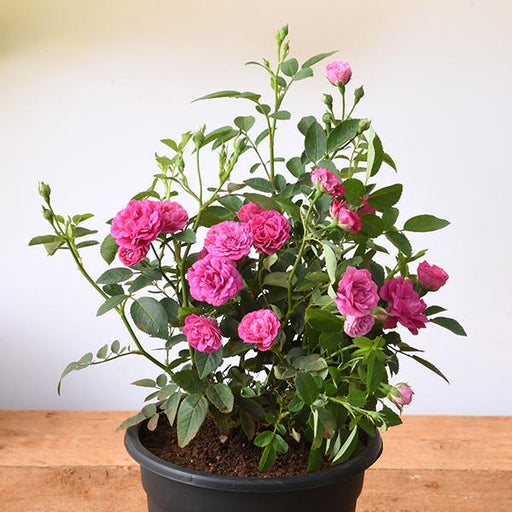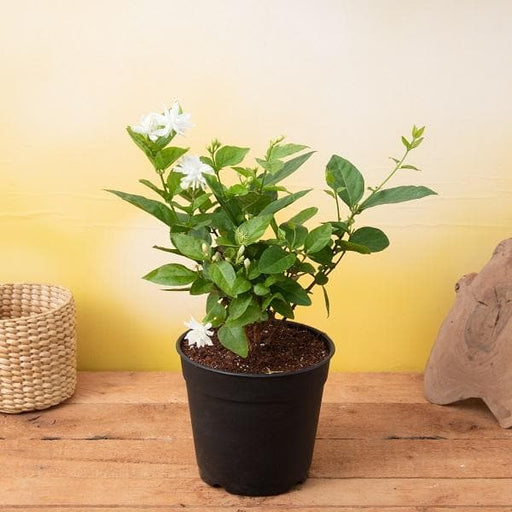
Caesalpinia coriaria - Plant
(MRP Inclusive of all taxes)
- Shipping ₹79 for entire order
- Dispatch in 7 days
- Country of origin: India

(MRP Inclusive of all taxes)
 Save 29%
Save 29%
Air Purifier Money Plant with Pot The Air Purifier Money Plant, also known as Pothos or Epipremnum aureum, is a stunning indoor plant that...
View full details
 Save up to 15%
Save up to 15%
Peace Lily, Spathiphyllum - Plant The Peace Lily, scientifically known as Spathiphyllum, is a stunning houseplant celebrated for its elegant white...
View full details
 Save 25%
Save 25%
Jasminum sambac, Mogra, Arabian Jasmine - Plant Jasminum sambac, commonly known as Mogra or Arabian Jasmine, is a fragrant flowering plant...
View full details
 Save 18%
Save 18%
Combo Constituents Includes the Parijat Tree (Night-Flowering Jasmine), a culturally significant plant with fragrant flowers. Description The Pari...
View full details
 Save 25%
Save 25%
Miniature Rose, Button Rose (Any Color) - Plant The Miniature Rose, also known as the Button Rose, is a charming and compact flowering plant that ...
View full details Save 25%
Save 25%
Damascus Rose, Scented Rose (Any Color) - Plant The Damascus Rose, also known as Rosa damascena, is a timeless symbol of beauty and romanc...
View full details
 Save 17%
Save 17%
Beautiful Fragrant Mogra, Arabian Jasmine Plant with Pot The Beautiful Fragrant Mogra, also known as Arabian Jasmine (Jasminum sambac), is...
View full details Save 15%
Save 15%
Pack of Vermicompost and Neem Cake for House Plants Transform your indoor garden with our premium Pack of Vermicompost and Neem Cake, spec...
View full details
Pack of Plant Growth and Flower Boosters Unlock the full potential of your garden with our Pack of Plant Growth and Flower Boosters! This ...
View full details Save 38%
Save 38%
Combo of Jeevamrut and Neem Raksha for Easy Growth and Protection of Houseplants Transform your indoor garden with our exclusive combo of ...
View full details Save 22%
Save 22%
Plant Nutrients Kit (Pack of 16) for a Healthy Garden Transform your garden into a lush paradise with our Plant Nutrients Kit, featuring 1...
View full details Save 16%
Save 16%
Combo of Top Plant Fertilizers Elevate your gardening game with our exclusive Combo of Top Plant Fertilizers, featuring two bags of premiu...
View full details Save 24%
Save 24%
Pack of 4 Additives to Make Soil Healthy and Nutrient Rich Transform your garden into a thriving ecosystem with our Pack of 4 Additives de...
View full details Save 30%
Save 30%
Transform your gardening experience with our premium Combo of Perlite and Vermiculite. This unique blend is designed to enhance soil aeration and ...
View full details Save 27%
Save 27%
Combo of 2 Vermicompost and Cocopeat - Enrich Your Soil Naturally! Transform your garden into a thriving ecosystem with our Combo of 2 Ver...
View full details
 Save 35%
Save 35%
Best 6 Plants for Perfect Indoor Garden Transform your living space into a lush oasis with our curated collection of the Best 6 Plants for a...
View full details
 Save up to 50%
Save up to 50%
Mini Succulent Garden Pack Transform your space with our Mini Succulent Garden Pack, featuring a delightful collection of 4 any variety beautiful s...
View full details
 Save 30%
Save 30%
5 Best Fragrant Plants Transform your garden or indoor space into a fragrant paradise with our curated selection of the 5 Best Fragrant Plants. Th...
View full details
 Save 24%
Save 24%
Set of 2 Bonsai Looking Grafted Adeniums Transform your indoor or outdoor space with our exquisite Set of 2 Bonsai Looking Grafted Adenium...
View full details Save 45%
Save 45%
Top 4 Die Hard Succulents Pack Transform your indoor or outdoor space with our Top 4 Die Hard Succulents Pack, featuring a curated selecti...
View full details
 Save 30%
Save 30%
5 Best Indoor Plants Pack Transform your living space into a lush oasis with our '5 Best Indoor Plants Pack.' This carefully curated collection fe...
View full details
 Save 25%
Save 25%
Set of 4 Evergreen Air Purifier Plant Pack Transform your indoor space into a lush, green oasis with our Set of 4 Evergreen Air Purifier Pla...
View full details| SrNo | Item Name |
|---|---|
| 1 | Caesalpinia coriaria - Plant |
Caesalpinia coriaria, commonly known as the Divi-divi tree, is a remarkable plant native to the tropical regions of Central and South America. This deciduous tree is renowned for its unique, twisted branches and small, fragrant yellow flowers that bloom in clusters. The tree can grow up to 10 meters tall and is often found in arid and semi-arid environments, making it a resilient choice for landscaping and ecological restoration.
What makes Caesalpinia coriaria special is its ability to thrive in poor soil conditions while providing essential habitat for various wildlife species. Its pods contain a natural gum, which has been historically used in the production of inks and dyes, showcasing its economic importance. Additionally, the tree's foliage is a vital food source for local fauna, contributing to biodiversity.
One of the standout features of Caesalpinia coriaria is its nitrogen-fixing capability, which enhances soil fertility and promotes sustainable agricultural practices. This characteristic not only benefits the plant itself but also supports surrounding flora, making it an excellent choice for reforestation projects.
If you’re looking for a tree that’s not just a pretty face, look no further! Caesalpinia coriaria, also known as the Divi-divi tree, is a multitasker. It provides shade, enhances soil quality, and even offers medicinal properties. Imagine having a tree that not only beautifies your garden but also helps your soil and your health. Talk about a green thumb’s dream!
Caring for your Caesalpinia coriaria is like nurturing a diva—she needs attention but rewards you handsomely! This tree thrives in well-drained soil and loves the sun. Water it moderately, and watch it flourish. Just remember, too much love (or water) can lead to root rot. So, treat it right, and it’ll be the star of your landscape!
This tree isn’t just a pretty sight; it’s a Swiss Army knife of the plant world! From providing shade to being a source of tannins for leather production, Caesalpinia coriaria is versatile. Its pods can be used in traditional medicine, and its wood is durable. Who knew a tree could be so useful?
If you’re impatient for instant gratification, Caesalpinia coriaria might just be your new best friend. This tree boasts a moderate growth rate, meaning you won’t be waiting eons for it to reach its full glory. With the right conditions, you’ll see it grow tall and proud, making it a perfect addition to your garden without the long wait.
Want to spread the love? Propagating Caesalpinia coriaria is easier than pie! You can start it from seeds or cuttings, and with a little patience and care, you’ll have new trees sprouting up in no time. Just remember, good things come to those who wait—so don’t rush the process!
This tree is a true globetrotter! Native to tropical and subtropical regions, Caesalpinia coriaria thrives in various habitats, from dry forests to coastal areas. It’s like the tree equivalent of a world traveler, adapting to different environments while still looking fabulous.
Every diva has her detractors, and Caesalpinia coriaria is no exception. While generally resilient, it can attract pests like aphids and caterpillars. But fear not! A little vigilance and some organic pest control can keep these uninvited guests at bay. After all, no one wants a party crasher in their garden!
If you want your Caesalpinia coriaria to thrive, you need to roll out the red carpet—well, sort of. This tree prefers well-drained, sandy to loamy soils. It’s not too picky, but it definitely doesn’t want to sit in soggy conditions. Give it the right soil, and it’ll reward you with stunning foliage!
This tree is a sun worshipper! Caesalpinia coriaria flourishes in warm climates, making it perfect for those sunny spots in your garden. It can tolerate drought, but it’s not a fan of frost. So, if you live in a chilly area, you might want to consider a cozy greenhouse for this tropical beauty.
Who knew your garden could double as a pharmacy? Caesalpinia coriaria has been used in traditional medicine for its anti-inflammatory and astringent properties. From treating wounds to digestive issues, this tree packs a punch. Just remember, while it’s great for home remedies, consult a professional before diving into herbal treatments!
Looking to add some flair to your landscape? Caesalpinia coriaria is your go-to tree! With its unique shape and vibrant flowers, it’s a showstopper. Whether used as a focal point or in a mixed border, this tree will elevate your garden game. Get ready for compliments from neighbors and passersby alike!
Caesalpinia coriaria, also known as the divi-divi tree, is a tropical beauty native to Central and South America. This leguminous wonder boasts stunning yellow flowers and a unique, twisted trunk. It’s like nature’s own pretzel, perfect for adding flair to your garden or landscape!
Caring for Caesalpinia coriaria is a breeze! Just give it well-drained soil, plenty of sunlight, and occasional watering. It thrives in dry conditions, so don’t drown it! Think of it as a sunbather who enjoys a good tan without the hassle of sunscreen.
Caesalpinia coriaria isn’t just a pretty face! It provides shade, attracts pollinators, and its pods are used in traditional medicine. Plus, its wood is durable and can be used for crafts. It’s like the Swiss Army knife of plants—versatile and always handy!
Absolutely! Caesalpinia coriaria is the ultimate drought warrior. Once established, it can withstand dry spells like a champ. Just think of it as the plant equivalent of a camel, storing up water and looking fabulous while doing it!
Yes, you can! Growing Caesalpinia coriaria in pots is like giving it a stylish apartment. Just ensure the pot has good drainage and enough space for its roots to stretch. It’ll thrive and may even throw a little plant party!
Caesalpinia coriaria is a speedy grower, reaching heights of up to 20 feet in ideal conditions. It’s like the Usain Bolt of the plant world—quick and impressive! Just give it the right environment, and it’ll be towering over your garden in no time.
While Caesalpinia coriaria is generally pest-resistant, it can occasionally attract aphids or caterpillars. Think of them as uninvited guests at a party. A little neem oil or insecticidal soap can send them packing, ensuring your plant remains the star of the show!
Caesalpinia coriaria loves warm, tropical climates and isn’t a fan of frost. If you live in a cooler area, consider it a seasonal visitor—bring it indoors during winter. It’s like that friend who only shows up for summer BBQs!
Propagating Caesalpinia coriaria is as easy as pie! You can start from seeds or cuttings. Soak the seeds overnight for a head start, or take a cutting and let it root in water. Soon, you’ll have a mini forest of divi-divi trees!
Caesalpinia coriaria prefers sandy, well-drained soil. Think of it as a beach-loving plant that hates soggy feet. If your soil is heavy, mix in some sand or gravel to create a paradise for this tropical gem!
Absolutely! Caesalpinia coriaria is a landscaping superstar. Its unique shape and vibrant flowers make it a stunning focal point. Whether in a garden or as a street tree, it’ll turn heads and have neighbors asking for your gardening secrets!
Caesalpinia coriaria can live for several decades, making it a long-term investment in your garden. It’s like that reliable friend who’s always there for you—growing strong and beautiful year after year, providing shade and charm!